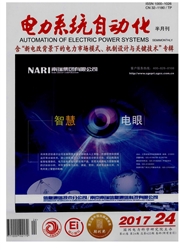

 中文摘要:
中文摘要:
由于微网中含有发电单元输出功率与负荷功率2组不相关随机变量,储能需要频繁吸收(发出)有功功率以维持微网的稳定运行,这对传统蓄电池储能的工作状况产生了较大的负面影响,缩短了其使用寿命。文中提出了适用于微网的超级电容器与蓄电池混合储能结构,采用统一建模方法进行了建模,并采用小信号分析方法推导了储能的稳定条件。针对该混合储能结构,采用多滞环调节控制策略提高了储能的灵活性与实用性。利用超级电容器功率密度高和循环寿命长的优点,通过控制双向DC/DC变换器实现对蓄电池充放电过程的优化控制,可以避免蓄电池单独储能时的容量浪费,延长其使用寿命,提高储能的技术经济性。仿真和实验结果验证了所提出的混合储能结构及其控制策略的有效性。
 英文摘要:
英文摘要:
Because of the uncertainties and significant fluctuations of both power generation and consumption in a microgrid, the lead-acid battery energy storage system (BESS) endures too large fluctuations in battery charge and discharge currents to maintain the battery lifetime. This paper presents a hybrid energy storage system composed of super-capacitors and batteries. The mathematical model is given and its small signal stability criteria is also derived. Based on the topology of the hybrid energy storage system, the multi-hysteresis control strategy is adopted to improve the flexibility and practicability of the energy storage. Comparing the hybrid energy storage system with the BESS, it can be concluded that because of the high power density of the super-capacitor and the optimized control of the bi-directional DC/DC converter, some advantages can be attained. These include higher capacity usage rate and reduction of maintenance interruptions and operation costs. Both the simulation and experimental results verify the excellent performance of the proposed hybrid energy storage system.
 同期刊论文项目
同期刊论文项目
 同项目期刊论文
同项目期刊论文
 期刊信息
期刊信息
